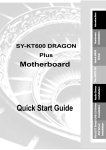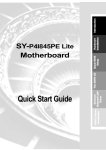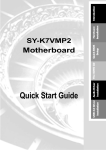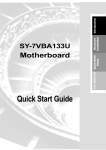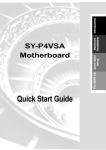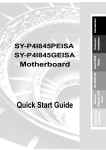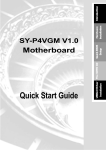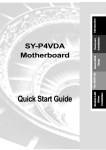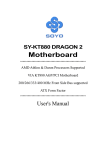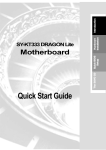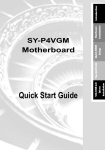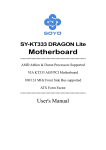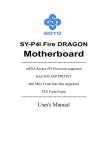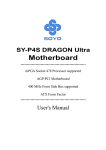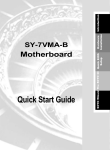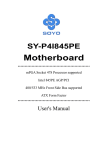Download SOYO SY-K7VMP User's Manual
Transcript
Quick Start Guide Audio Driver Installation The SOYO CD Quick BIOS Setup Motherboard USB 2.0 Driver Installation Hardware Installation SY-K7VMP Introduction SOYO™ 1. AGP cards running at 3.3V are not supported, only AGP cards running at 1.5V can be used in this mainboard. 2. Please read the user guide before proceeding with your installations. Serious damage may occur if the procedure is not followed properly. 3. If you have any problem getting your system to work, please follow the troubleshooting tips in your user guide. 4. For immediate Technical questions, please visit http://www.soyousa.com/support and http://www.soyousa.com/kb. 2 SOYO™ SY-K7VMP Motherboard AMD® K7 Athlon & DuronTM processors VIA KM400 AGP/PCI Motherboard 100/133/166 MHz Front Side Bus supported ATX Form Factor Copyright © 2003 by SOYO Computer Inc. Trademarks: SOYO is a registered trademark of SOYO Computer Inc. All trademarks are properties of their owners. Product Rights: All names of the product and corporate mentioned in this publication are used for identification purposes only. The registered trademarks and copyrights belong to their respective companies. Copyright Notice: All rights reserved. This manual has been copyrighted by SOYO Computer Inc. No part of this manual may be reproduced, transmitted, transcribed, translated into any other language, or stored in a retrieval system, in any form or by any means, such as by electronic, mechanical, magnetic, optical, chemical, manual or otherwise, without permission in writing from SOYO Computer Inc. Disclaimer: SOYO Computer Inc. makes no representations or warranties regarding the contents of this manual. We reserve the right to amend the manual or revise the specifications of the product described in it from time to time without obligation to notify any person of such revision or amend. The information contained in this manual is provided to our customers for general use. Customers should be aware that the personal computer field is subject to many patents. All of our customers should ensure that their use of our products does not infringe upon any patents. It is the policy of SOYO Computer Inc. to respect the valid patent rights of third parties and not to infringe upon or to cause others to infringe upon such rights. Restricted Rights Legend: Use, duplication, or disclosure by the Government is subject to restrictions set forth in subparagraph (c)(1)(ii) of the Rights in Technical Data and Computer Software clause at 252.277-7013. About This Guide: This Quick Start Guide can help system manufacturers and end users in setting up and installing the motherboard. Information in this guide has been carefully checked for reliability; however, to the correctness of the contents there is no guarantee given. The information in this document is subject to amend without notice. For further information, please visit our Web Site on the Internet. The address is "http://www.soyo.com.tw". K7VMP Series - Version P1.0- Edition: July 2003 * These specifications are subject to amend without notice 3 1 Introduction Congratulations on your purchase of the SY-K7VMP motherboard. This Quick Start Guide illustrates the steps for installing and setting up your new motherboard. This guide provides all users with the basic steps of motherboard setting and operation. For further information, please refer to the SY-K7VMP motherboard User’s Manual that came with your motherboard. Unpacking When unpacking the motherboard, check for the following items: The SY-K7VMP AGP/PCI Motherboard The user manual The Installation CD-ROM One IDE Device ATA 133 Flat Cable One Floppy Disk Drive Flat Cable 1394 One Heat Sink Compound One 1394 Bracket 1394 Introduction SY-K7VMP Quick Start Guide One Back Panel 4 Introduction SY-K7VMP Quick Start Guide SY-K7VMP Layout PS/2 KB PS/2 Mouse Connector Connector ABR 1 2 USB 1/USB 2 COM A VGA out PRT LAN Connector ATX Power USBLAN MIC IN / Center & Bass out Audio out / Front out J30 Audio in / Rear out 8 7 2 1 AC97 codec IDE 1 IDE 2 3 LAN Chip 3V Lithium Battery 1 CDSPDO AUXIN1 PCI Slot #1 CDIN1 PCI Slot #2 1 9 1 1 2 COM2 PCI Slot #3 5 USB20_1 10 I/O CHIP PCI Slot #4 JP5 VT6307 PCI Slot #5 6 2 SIRCON 1 5 1 15 1 GAME1 FW1 5 10 6 5 1 10 5 FW2 FLP Introduction SY-K7VMP Quick Start Guide Key Features CPU Supports AMD 462 pins Socket A processors : Athlon XP (Palomino/Thoroughbred/Barton) (200/266/333 MHz FSB) Duron/Morgan SOYO COMBO Setup CMOS setup menu for complete and easy changing of your CPU settings in CMOS setup, making jumpers obsolete. Chipset VIA® KM400/ 8235 Chipset VGA UniChrome™ 2D/3D Graphics with motion compensation Memory Supports PC2100 and PC2700 DDR (non-registered and non-ECC) memory modules. SOYO COMBO Setup menu, to fully configure your memory settings. AGP 1x AGP master 4x/8x slot (1.5v only) PCI 5x 32-bit bus master PCI slots Super I/O ITE IT8705F Super I/O controller supporting : Floppy disk controller Parallel port (SPP, EPP and ECP compliant) 2x 16550A compatible RS232 serial ports ( 1x rear, 1x motherboard connector) IrDA compatible infrared port Gameport header PS/2 Keyboard and mouse Hardware monitor for monitoring temperatures, voltages and fan speeds in the system. Storage 8235 Integrated Parallel ATA controller supporting up to 4x UDMA 33/66/100/133 Parallel ATA devices. USB 2.0 6x USB 2.0 compliant ports (4x on rear IO panel, 2x motherboard connectors. IEEE 1394 Onboard VIA VT6307 IEEE1394 Firewire controller with 2x motherboard connectors 6 Sound Onboard VIA VT1616 6 channel Audio Codec Network 10/100 MBps 100Base-T Ethernet controller, supporting Wake-On-Lan (WOL) BIOS Power Failure resume function to allow the system to turn on or off after a power failure, which is indispensable for server systems. Wake On Ring and Power On by Alarm to allow your system to wake up from suspend or power on through the modem or RTC alarm. Multiple boot, allowing your system to boot from for example CD-ROM Software SOYO Hardware Doctor allowing you to fully monitor and control your system SOYO Bonus Pack CD-ROM containing free bonus software. Industry standards This motherboard is compliant with the following industry standards : Microsoft PC99 FCC ACPI 7 Introduction SY-K7VMP Quick Start Guide SY-K7VMP Quick Start Guide 2 Installation Installation To avoid damage to your motherboard, please follow these simple rules while handling this equipment: Before handling the motherboard, ground yourself by touching on to an unpainted portion of the system's metal chassis. Remove the motherboard from its anti-static packaging. Hold the motherboard by the edges and avoid touching its components. Check the motherboard for damage. If any chip appears to be loose, press carefully to seat it firmly in its socket. Follow the directions in this section, which is designed to guide you through a quick and correct method to install your new SY-K7VMP motherboard. For detailed information, please refer to the SY-K7VMP motherboard User's Manual and Technical Reference online manual on the CD-ROM package that came with your motherboard. Gather and prepare all necessary components to complete the installation successfully: Socket A processor with CPU cooling fan (boxed type) DDR SDRAM module(s) Computer case with adequate power supply unit Monitor PS/2 or USB Keyboard Pointing Device (PS/2 or USB Mouse) Speaker(s) (optional) Disk Drives: HDD, CD-ROM, Floppy drive… External Peripherals: Printer and Modem (optional) Internal Peripherals: Modem and LAN cards (optional) Note: If you want to use an external speaker connected to "Line-out" port, please make sure to use an "amplified speaker" that can generate proper output sound volume. 8 SY-K7VMP Quick Start Guide Install the Motherboard We will now begin the installation process. Please follow the step-by-step procedure designed to lead you to a complete and correct installation. Step 1- Install the Central Processing Unit (CPU) Installation Step 2- Install memory modules Step 3- Install expansion cards Step 4- Connect cables, case wires, and power supply Step 1. Install the CPU CPU Mount Procedure: To mount the AMD® K7 AthlonTM, AthlonTM XP & DuronTM processor that you have purchased separately, follow these instructions. 1 2 3 4 1. Lift the socket handle up to a vertical position. 2. Align the blunt edge of the CPU with the matching pinhole edge on the socket. 3. Seat the processor in the socket completely and without forcing. 4. Then close the socket handle to secure the CPU in place. Remember to connect the CPU Cooling Fan to the appropriate power connector on the motherboard. The fan is a key component that stabilizes the system. It prevents the equipment from overheating and prolongs the life of your CPU. If your FAN is not connected or connected improperly your CPU can be permanently damaged. 9 SY-K7VMP Quick Start Guide 5. Set the jumpers on the FJ1 jumper block to the correct FSB for your CPU. FJ1 100 MHz 133 MHz 166 MHz Installation FSB Clock Select CPU Fan Installation Your Socket A processor kit comes with a cooling fan. Mount the fan on the processor according to the instructions provided by the manufacturer. The fan is a key component that will ensure system stability. The fan prevents overheating, therefore prolonging the life of your CPU. Note: Remember to connect the fan to the appropriate power source. CPU Fan Mount Procedure: To prevent scratch or damage on the motherboard, please follow the instructions on how to mount the CPU fan properly. 1. Apply thermal paste to the die of the CPU. 10 SY-K7VMP Quick Start Guide Installation 2. Carefully mount the fan on top of the CPU and clip-on the first lock. 1 3. Clip-on the second lock and please make sure not to damage/scratch the board. 2 11 SY-K7VMP Quick Start Guide Installation 4. Connect the power connector to CPUFAN1. DIMM1 DIMM3 Note: If the fan is defective or Power connector is not connected to CPUFAN1, the system will enable Fan Off Control function. See below for more information on FOC function. When the CPU temperature exceeds, the temperature set in the CPU Temp. Protection in BIOS setup, SOYO’s Anti Burn Regulator (ABR) will automatically shutdown the system and beep until the power button is pressed for one time. FOC (Fan-Off Control) The newly designed SOYO “FOC” is based on the concept of total protection for the CPU, which is very different from what is currently seen on the market. The H/W control function is used to see a passive security system of monitoring and warning. S/W Simultaneous Signal Follow-up techniques and Auto Power Off System are included to prevent possible damage caused by the malfunctioning of the CPU fan. With the help of “O/S On Time Monitoring And Warning” function, provided by the H/W monitoring system, the double-protection purpose is achieved. 12 SY-K7VMP Quick Start Guide “FOC” includes the following functions: Auto Power Off System: If the BIOS receives the information of CPU fan revolution, it continues to function normally. If no signal is received, it will inform the system and disconnect the power supply immediately to protect the CPU from overheating. Note: The following must be observed to secure the normal functioning of “Fan-Off Control”: 1. FOC only works on CPUFAN 1. 2. A CPU fan with sensor pin must be used. 3. CPU fans approved by AMD are strongly recommended. The “HOT KEY” function is provided for the CPU fans without sensor pins, to avoid the power off. Users may press the “Insert” key to jump over the “Power Off” mode; go to the BIOS and disable “FOC”. Now system can be booted normally. We provide the following User-Friendly protection features: 1. Fan-Off Control: The motherboard detects the status of the CPU fan and protects the CPU by automatically disconnecting the power supply. The default value of this function is Enable. After booting up, the user may disable it. 2. Heat Dissipation Paste: Heat Dissipation Paste is included for all Socket-A motherboards, to enhance the heat dissipation capability. Furthermore, we strongly recommend our users to enable the function of H/W monitoring in the BIOS. This function, together with the FOC, provides the total protection to the CPU and allows it to maximize its performance. Note: FOC will only work during BOOT-up. Once the system enters the operating system, FOC will be disabled. 13 Installation Simultaneous Signal Follow Up: Before the system enters the O/S, H/W will detect the signals of the CPU fan pins, get their revolution information and send it to the BIOS. SY-K7VMP Quick Start Guide ABR (Anti Burn Regulator) Installation SOYO's ABR (Anti Burn Regulator) is a specially designed hardware circuit that works hand in hand with the CPU’s internal sensor in monitoring the temperature of the CPU and prevent it from overheating. Once the heat accumulated in the CPU is over the set limit. ABR will automatically shut down the system power and warn you with a beeping sound. To de-activate the beeping sound, un-plug the AC power cord. We recommend you to check the cause of the overheating and let the processor cool down before powering on the system. Note: ABR supports AMD Athlon XP and Morgan CPU. Thunderbird and Duron CPUs are not supported Some early versions of the 2400+ and 2600+ XP CPUs when used in this motherboard will automatically activate the ABR function, thus making a beeping sound and shut down your system. If this compatibility issue arises, you need to disable the ABR function via the ABR hardware jumper. Enabled Disabled ABR Jumper 1 2 1 2 Step 2. Configure Memory Your board comes with three DIMM sockets, providing support for up to 3GB of main memory using unbuffered and non-ECC DIMM modules. On this motherboard, DRAM speed can be set independent from the CPU FSB speed. Memory Configuration Table Number of Memory Modules DIMM 1 DIMM 2 DIMM 3 RAM Type DDR RAM PC2100/PC2700 (non-register & non-ECC) Memory Module Size (MB) 128 / 256 / 512 / 1024 MB 14 SY-K7VMP Quick Start Guide Step 3. Installation of Expansion Cards 1. Read the related expansion card’s instruction document before inserting the expansion card into the computer. 2. Press the expansion card firmly into expansion slot in the motherboard. 3. Make sure the metal contacts on the card are correctly seated in the slot. 4. Replace the screw to secure the slot bracket of the expansion card. 5. Install driver for the operating system you use. Note: AGP cards working on 3.3V are not supported. Only AGP cards working on 1.5V can be used in this M/B. For AGP card voltage specification, please check the AGP card manual or contact your AGP card’s manufacturer. Step 4. Connections to the Motherboard This section tells how to connect internal peripherals and the power supply to the motherboard. The internal peripherals consist of IDE devices (HDD, CD-ROM), Floppy Disk Drive, Chassis Fan, Front Panel Devices (Internal Speaker, Reset Button, IDE LED and power switch), Wake-On-LAN card and other devices. For more details on connecting internal and external peripherals to your new SY-K7VMP motherboard, please refer to SY-K7VMP motherboard User's Manual and Technical Reference online manual on the CD-ROM. Connectors and Plug-ins Standard IrDA (Infrared Device Header): SIRCON Serial Port 2 : COM2 Pin1 Pin2 Pin3 Pin4 Pin5 Pin6 Pin7 Pin8 Pin9 Pin10 Pin1 Pin2 Pin3 CD DSR RxD RTS TxD CTS DTR NC IRRX GND IRTX CDSPDO RI GND NC VCC Pin4 Pin5 MIC & LED Connector J30 Pin1 Pin2 Pin1 Pin2 Pin3 Pin4 Pin5 Pin6 Pin7 Pin8 CDSPDO GND Line_Out_L AGND Line_Out_R AGND MIC IN2 AGND LAN_LINK_LE VCC GAMEPORT Pin1 Pin2 Pin3 Pin4 Pin5 Pin6 Pin7 Pin8 Pin9 Pin10 Pin11 Pin12 Pin13 Pin14 Pin15 Pin16 VCC VCC JOY A3 JOY B3 JOY A1 JOY B1 GND MIDI OUT GND JOY B2 VCC 15 JOY A2 JOY B4 JOY A4 MIDI IN NC Installation The motherboard has 1 AGP slot and 5 PCI slots. SY-K7VMP Quick Start Guide Pin1 Power Installation Pin1 A0PC Pin1 Pin2 Data(-) Pin2 GND Pin3 Data(+) Pin3 B0PC Pin2 USB20_1 Pin4 Pin6 GND Power Pin3 Pin7 Data(-) Pin8 Data(+) Pin9 GND Pin10 GND Pin4 NC 1394: FW1 Pin5 Pin6 PWR0 A0MC Pin7 CGND Pin8 B0MC Pin9 PWR0 Pin10 CGND Pin4 1394: FW2 Pin5 Pin6 Pin7 Pin8 Pin9 Pin10 A1PC GND B1PC NC PWR1 CPU Cooling Fan: CPUFAN1 Pin1 Pin2 Pin3 GND 12V A1MC CGND B1MC PWR1 CGND CPU Cooling Fan: CPUFAN2 Pin1 Pin2 Pin3 SENSOR GND Chassis Fan: CHAFAN1 Pin1 Pin2 Pin3 CONTROL 12V SENSOR Connect the CD Line-in cord from the CR-ROM CDIN1 device to the matching connector CDIN AUXIN1 Reset HDD LED HDD LED Pin1 LED Anode Pin2 LED Cathode Pin1 L Pin2 G Pin3 G Pin4 R L G G R Pin1 Power LED Pin2 Pin3 VCC NC GND Pin4 Speaker PWRBT NC Chassis Fan: CHAFAN2/3 Pin1 Pin2 Pin3 GND 12V NC CD -IN: CDIN1 / AUXIN1 Power LED 12V Pin1 Pin2 Speaker Pin3 VCC NC NC PWRBT Pin1 Power On/Off Speaker out RESET Pin2 GND Pin1 Control PIN Pin2 GND ATX Power On/Off: PWRBT Connect your power switch to this header (momentary switch type). To turn off the system, press this switch and hold down for longer than 4 seconds. ATX Power Supply: ATX PW Attach the ATX Power cable to this connector. (This motherboard requires an ATX power supply, an AT power supply can NOT be used.) Note: We recommend using an AMD approved power supply or at least 350W. When using the Power-On by PS/2 Keyboard function, please make sure the ATX power supply is able to provide at least 720mA on the 5V Standby lead (5VSB) in order to meet the standard ATX specifications. 16 SY-K7VMP Quick Start Guide CMOS Clear (JP5) 1. Clear the CMOS memory by momentarily shorting pin 2-3 on jumper JP5. Its white cap can easily identify this jumper. 2. Put the jumper back to 1-2 to allow writing of new data into the CMOS memory. CMOS Clearing JP5 Setting Clear CMOS Data Short pin 2-3 for at least 5 seconds to clear the CMOS Retain CMOS Data Short pin 1-2 to retain new settings Note: You must unplug the ATX power cable from the ATX power connector when performing the CMOS Clear operation. On-board Speaker connection When using 2-channel speaker, connect the speaker cable to Line-out. If you’re using 4 channel speaker, connect the front L/R speakers to Line-out and rear L/R speakers to Line-in. Make sure that the audio software is set for 4 channel speaker system. If you are using 6 channel speaker, connect the front L/R speakers to Line-out and the rear L/R speakers to Line-in. Connect the Center/Bass to Mic-in. Line-in Line-out Mic-in 17 Installation In some cases the CMOS memory may contain wrong data, follow the steps below to clear the CMOS memory. SY-K7VMP Quick Start Guide 3 Quick BIOS Setup This motherboard allows you to change your memory and onboard peripheral settings in BIOS setup. After the hardware installation is complete, turn the power switch on, then press the <DEL> key during the system diagnostic checks to enter the Award BIOS Setup program. The CMOS SETUP UTILITY will be shown on the screen. Then, follow these steps to configure your system. Step 1. Select [STANDARD CMOS SETUP] Set [Date/Time] and [Floppy drive type], then set [Hard Disk Type] to “Auto”. Quick BIOS Setup Step 2. Select [LOAD OPTIMIZED DEFAULTS] Select the “LOAD OPTIMIZED DEFAULTS” menu and type “Y” at the prompt to load the BIOS optimal setup. Step 3. Select [SAVE & EXIT SETUP] Press <Enter> to save the new configuration to the CMOS memory, and continue the boot sequence. 18 SY-K7VMP Quick Start Guide 4 The SOYO CD The SOYO-CD will Auto Run only in Windows Based Operating Systems. Your SY-K7VMP motherboard comes with a CD-ROM labeled "SOYO CD." The SOYO CD contains a. The user's manual for your new motherboard in PDF format, b. The drivers software available for installation, and c. A database in HTML format with information on SOYO motherboards and other products. Insert the SOYO CD into the CD-ROM drive If you are running Windows NT/2K/XP, the SOYO-CD will not detect your motherboard type. In that case the following dialog will pop up. Please choose your motherboard model number and press OK. Now the SOYO-CD Start Up Menu will come up as shown on the following page: 19 The SOYO CD Step 1. The SOYO CD SY-K7VMP Quick Start Guide (SOYO CD Start Up Program Menu) Under Windows 95/98/ME, the SOYO CD Start Up Program automatically detects the SOYO motherboard the system uses and displays the corresponding model name. The user's manual files included on the SOYO CD are in PDF (Postscript Document format). In order to read a PDF file, the appropriate Acrobat Reader software must be installed in your system. Note: The Start Up program automatically detects if the Acrobat Reader utility is already present in your system, and otherwise prompts you on whether or not you want to install it. You must install the Acrobat Reader utility to be able to read the user's manual file. Follow the instructions on your screen during installation, then once the installation is completed, restart your system and re-run the SOYO CD. 20 SY-K7VMP Quick Start Guide Step 2. Install Drivers and Utilities (Driver Installation Menu) A short description of all available drivers follows: VIA 4 in 1 Driver Package for Win 9x/ME/NT/2k/XP VIA 4 In 1 driver includes four system drivers to improve the performance and maintain the stability of systems using VIA chipsets. These four drivers are: VIA Registry (INF) Driver, VIA AGP VxD driver, VIA ATAPI Vendor Support Driver and VIA PCI IRQ Miniport Driver. VIA KM400 Onboard Display Driver for Win 9x/ME/NT/2k/XP This program will install the driver for the VIA Onboard Display adapter. Note that for Windows NT the driver installation should be done manually. Check the ReadMe included with the driver installation for more details. VIA Audio driver setup program for Win 9x/ME/2000/NT/XP This driver supports 2/4/6 speakers with 3D stereo enhancement. VIA USB2.0 Driver for Win 98/98SE/ME/2K This setup program will install the driver for VIA USB 2.0 Host Controller for Windows 98SE and Windows ME. For Windows XP, please check Chapter 6. 21 The SOYO CD Click the Install Drivers button to display the list of drivers software that can be installed with your motherboard. The Start Up program displays the drivers available for the particular model of motherboard you own. We recommend that you only install those drivers. SY-K7VMP Quick Start Guide K7VMP Hardware monitor for Win 9x/ME/2000/NT/XP Your motherboard comes with a hardware monitoring IC. By installing this utility, Temperature, Fan speed and Voltages can be monitored. It is also possible to set alarms when current system values exceed or fall below pre-set values. Step 3. Check the Latest Releases The SOYO CD Click the 'Check the latest Releases' button to go the SOYO Website to automatically find the latest BIOS, manual and driver releases for your motherboard. This button will only work if your computer is connected to the internet through a network or modem connection. Make sure to get your modem connection up before clicking this button. 22 SY-K7VMP Quick Start Guide The SOYO CD After Windows XP installation, your device manager should look like this: 23 SY-K7VMP Quick Start Guide The SOYO CD After driver installation, your Windows XP device manager should look like this: 24 SY-K7VMP Quick Start Guide Drivers directory list in the CD driver Audio driver Via4 in1 driver The SOYO CD Onboard LAN USB 2.0 driver for Win 98SE/ME KM400 VGA driver 25 SY-K7VMP Quick Start Guide 5 Audio Driver Installation Audio Driver Installation for Windows 98/98se After you have installed the audio driver, windows may prompt you to restart your computer. Audio Driver Installation When your computer has restarted it may look for the windows driver on your windows installation CD and ask you to insert your installation CD into your CD-drive. At this point you need to insert the windows installation CD into your CD-drive. You will then be prompted to select the correct directory on your windows CD. 26 SY-K7VMP Quick Start Guide 6 USB2.0 Driver Installation USB2.0 Driver Installation for Windows XP USB 2.0 drivers are available for download using Windows Update for Windows XP. For additional information regarding USB 2.0 support in Windows XP, please visit http://www.microsoft.com/hwdev/bus/USB/default.asp (Windows XP Service Pack1 Include USB2.0 Driver) After installing service pack1, please do the following: 1) Go into the device manager. 2) Remove ” ”. 3) Restart your system. USB 2.0 Driver Installation Next time Windows XP starts up a new USB 2.0 controller will be found. 27 SY-K7VMP Quick Start Guide Quick Trouble shooting tips Boot-up Issues The system does not power-up, no beeping sound heard and the CPU fan does not turn on. 1. Check if the power cord is plug into the power source. 2. Check if the power is connected to the M/B. 3. Check if the cable of the case power button is connected to the M/B power button connector (see Connectors and Plug-ins section in this Quick start guide for more info). 4. Make sure the power supply is not defective. Change the power supply. The minimum should be a 350 watts AMD recommended power supply. 5. Remove the M/B from the case and test the system. The M/B might be shorted to the case. Audio Driver Installation The system powers-up, but no video, or beeping sound heard. The CPU fan is turning. 1. Clear CMOS battery. (JP5 connector, see this Quick start guide for more info on how to clear the CMOS). 2. Check all the jumper settings on the M/B. 3. Check if the CPU is ok, by using another CPU (check the Quick start guide for CPU supported on this M/B). 4. Check if the power supply is ok. The minimum should be 350 watts, AMD approved. 5. Make sure the CPU fan is connected to CPUFAN1 connector. 6. Remove the M/B from the case and test the system. The M/B might be shorted to the case. The system power-up, no video, beeping heard. 1. Clear CMOS battery. (JP5 connector, see this Quick start guide for more info on how to clear the CMOS). 2. Check all the jumper settings on the M/B. 3. Check if the memory module and the VGA card (if onboard VGA is not used) are inserted properly in the M/B. 4. If yes, change the memory module, it might be defective. Make sure the memory specification is supported by the M/B. (for more info on this, check our FAQ on the website). 5. Change the VGA card (if used). The system turns on for some seconds then shutdown by itself. 1. Check if the CPU fan is connected to the CPUFAN1 connector. 2. The CPU might be overheating. Check the CPU fan if it is defective, also see if the CPU fan is in contact with the CPU. 3. Clear CMOS battery. (JP5 connector, see Quick start guide for more info on how to clear the CMOS). 4. Make sure the power supply you have on your system support the M/B specification. 28 SY-K7VMP Quick Start Guide Example. If you have a P4 M/B, you need to use a P4 power supply. 5. If you already checked the power supply specification, change the power supply it might be defective. The minimum is 350 watts AMD approved. When I boot up my system, everything works fine, it sees my CPU and memory, detects my hard drive, floppy drive and CD-ROM but locks up at "Verify DMI pool data... ". It doesn’t boot go any further. What should I do? 1. Clear CMOS battery. (JP5 connector, see Quick start guide for more info on how to clear the CMOS). 2. If still has the problem, remove all other add-on cards (use onboard vga) and see if it boots further. Then put peripherals in one by one to identify which one of them causes the lockup. 3. Change the CPU. During Boot-up, my computer says CMOS memory Checksum error. What can be the problem? 1. Clear CMOS memory. 2. Re-flash BIOS. Check on how to flash BIOS on the later part of this guide. 3. Change the CMOS battery, the battery might be drained. 4. The BIOS chip might be failing. I hear a 1-2 beeping sound and then the system shut down, what is the problem? Verify that the CPU fan is connected to the CPUFAN1 connector. Stability Issues My system intermittently locks up, very unstable 1. Check the CPU Temperature, your CPU might be overheating. Change the CPU FAN. 2. Do not overclock your CPU 3. 4. Check the specification of the memory module, maybe the M/B does not support it. Go to BIOS setup and load fail safe settings. Please check if the system performance in the BIOS setup is set to Turbo/Maximum. Set it to normal if this is the case 5. 6. Check the website for the latest BIOS update. Check the website for FAQ’s regarding instability issues. 7. Change the memory module or CPU. 8. The power supply might not have enough wattage to support all the peripherals. If your system has other peripherals connected, like CD-RW, extra HDD, etc. disconnect them, or use a power supply with a higher wattage. 9. Install the VIA 4 in 1 driver set. My system intermittently locks up, during Windows installation. 1. Go to BIOS and load the “load optimized defaults”. 2. Check the website for any BIOS updates. 29 SY-K7VMP Quick Start Guide 3. If you still have the problem, remove all other add-on cards except for CPU/ Memory/ onboard Video/ Hard disk. See if you can finish Windows installation. Then put peripherals in one by one to identify which one causes the lockup. My system will not boot-up when I set my CPU to 133MHz FSB. It works with 100MHz FSB 1. Make sure to put some thermal paste on the CPU. 2. CPU might be defective. 3. Use an AMD approved power supply of at least 350 watts. If the problem persists, try booting with only onboard VGA/harddisk/memory and see if the problem disappears. If it does, likely you need a power supply that has a higher wattage. BIOS Issue Where can I find the BIOS revision of my mainboard? It will be displayed on the upper-left corner of the screen during boot-up. It will show as your board type followed by the revision number, such as kvxa_2BA1 (meaning BIOS revision 2BA1 for the SY-K7V Dragon plus! mainboard) or 6BA+ IV_2AA2 which means SY-6BA+ IV motherboard, with a 2AA2 BIOS. Where can I find the latest BIOS of my motherboard? Please go to the technical support page of one of the SOYO websites (Taiwan: www.soyo.com.tw, US: www.soyousa.com, Germany: www.soyo.de), and look up your motherboard to find the latest BIOS revision. Audio Driver Installation How can I flash the BIOS? 1. Download the BIOS on our support website. 2. Make a bootable floppy disk with out any memory manager loaded (i.e. himem, emm386, etc…). 3. Copy the BIOS file and awdflash utility to the diskette. 4. On the CMOS setup and disable CIH 4-way protection. 5. Type "awdflash biosname.bin /sn /py". 6. Reboot. After flashing the BIOS, my system will not boot-up. 1. Try clearing the CMOS. 2. The BIOS chip is defective due to an unsuccessful flash, contact your nearest SOYO branch for re-flashing. Is there a way to reprogram my BIOS after an unsuccessful flash? No other way, you need to send back the BIOS ROM to your nearest SOYO branch for re-flashing. 30 SY-K7VMP Quick Start Guide I’m using a 133MHz FSB CPU, I cannot find the DDR 100MHz option in the BIOS, why? The DDR speed should not be lower than the CPU FSB speed. VGA Issue I cannot set my VGA to go higher than 16 color (640x 480). 1. Make sure that you have installed the VIA 4 in 1 driver set. 2. Install/ re-install the VGA driver. After waking up from Suspend to RAM or Standby mode, the screen has no display but I can hear the hard disk operating 1. Install the VIA 4 in 1 driver set. 2. Check the VGA card manufacturer for a driver update (if using a different video card then the onboard video), and make sure the VGA card supports the Suspend to Ram function. 3. Update your VGA card’s BIOS (in the case of a video card other then the onboard video). Check your VGA card manufacturer for more details. Audio Issue How can I disable the on-board Audio? Go to the SOYO Combo Feature in BIOS setup, then set the “AC97 Audio” setup option to disabled. I cannot get the sound working on my system. 1. Check if the speaker wire is connected to the line out connector on the M/B. 2. Check if the speaker power is powered on. 3. Install the audio driver supplied on our driver disc. 4. Check BIOS setup if “AC97 Audio” setup option is enabled. 5. If sound already installed, check our website for audio driver updates. I cannot get the sound working using 5.1 channel speakers. 1. Install the audio driver and application. Check driver installation for more info. 2. Check if the settings in the VIA Mixer program and in the Control Panel are correct. 3. Check if the speaker connection to the M/B is correct. 4. Make sure the software setup is correct. Check the manual for more info. The sound is working in my system, but when I play CD music from the CD-ROM, I do not get any sound. What is wrong? This is because the 3-wire audio cable from the CD-ROM to the on-board CDIN1 connector in the M/B is not connected. See the beginning of this guide for the location of CDIN1. 31 SY-K7VMP Quick Start Guide The sound and everything else works fine except that the line-in and microphone do not work. What is wrong? 1. Please go to sound properties and check if the line-in and microphone in are enabled and not muted. 2. Check if the Microphone is ok. 3. When using 6 speakers the line-in and microphone channels are used for rear, center and bass. 6-Channel audio and microphone/line-in can not be used at the same time. Hard disk/FDD/ CD-ROM issue My Western digital HDD is not detected during boot-up. Change the jumper settings to cable select or single. Sometimes the system finds my CD-ROM, sometimes not. 1. Check CD-ROM if it is working properly. 2. The power supply might not have enough wattage to support all the peripherals. If your system has other peripherals connected, like CD-RW, extra HDD, etc. disconnect them. When I boot up my new computer, I get "floppy boot failure" and the LED on the floppy stays on. Make sure the red wire of floppy ribbon cable goes to Pin1 on the floppy drive side (don't trust the "key lock" or "notch") and use the end-connector of the cable (don't use middle one). LAN Issues Audio Driver Installation During LAN driver installation, the system hangs on 75%, why? Enable the onboard LAN in the BIOS setup. I have problem installing Novell NetWare v.50. Disable the APIC option in the BIOS. For updated FAQs, please check http://www.soyo.com.tw/faq.htm or http://www.soyousa.com/faqs.html 32 SY-K7VMP Quick Start Guide How to contact us: If you are interested in our products, please contact the SOYO sales department in the region you live. If you require Technical Assistance, please contact our Technical Support in the region you live. SOYO prefers Email as communication medium, remember to always add to the email the country that you live in. TAIWAN Hong Kong SOYO COMPUTER INC. SOYO ASIA LTD. No. 21 Wu-Kung 5 Rd., Hsing Chuang City, Taipei Hsien, Taiwan, R.O.C. 5C, Big Star Centre, 8 Wang Kwong Road, Kowloon Bay, Kowloon, Hong Kong TEL: 886-2-22903300 FAX: 886-2-22983322 http://www.soyo.com/ Email: [email protected] TEL: 852-2-710-9810 FAX: 852-2-710-9078 http://www.soyo.com.hk/ Email: [email protected] USA SOYO INC. 41484 Christy Street, Fremont, CA 94538, USA TEL: 1-510-226-7696 FAX: 1-510-226-9218 http://www.soyousa.com/ http://www.soyousa.com/kb Email: [email protected] GM SOYO Deutschland GmbH (SAAT Technology GmbH) August-Wilhelm-Kuhnholz-Str. 15, D-26135 Oldenburg (Oldb), Germany TEL: 49-441-209100 FAX: 49-441-203442 http://www.soyo.de/ Email: [email protected] 33 Edition: July 2003 Version P1.0 SY-K7VMP SERIAL


































